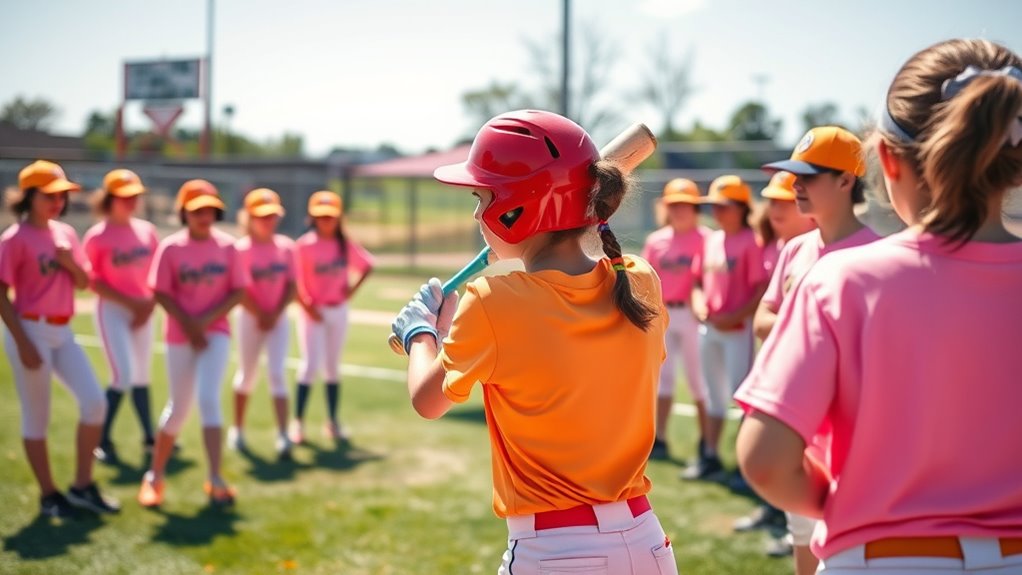Inside softball practice, beginners typically focus on warm-up exercises, fundamental throwing drills like long toss and target practice, and fielding ground balls and fly balls to build proper technique. You’ll also practice batting to develop your swing and accuracy, along with relay and communication drills to improve team coordination. Situational play exercises help you make quick decisions under pressure. Keep learning these key drills to improve your skills and gain confidence on the field.
Key Takeaways
- Beginners practice warm-up routines, basic throwing, fielding, catching, and batting drills to build fundamental skills.
- Sliding techniques and running form drills emphasize safety and efficiency during base running.
- Relay, communication, and team coordination exercises improve teamwork and in-game efficiency.
- Situational play drills simulate game scenarios to develop decision-making and mental toughness.
- Overall practice integrates skill development, safety, teamwork, and strategic thinking for comprehensive growth.
Warm-Up Exercises and Stretching
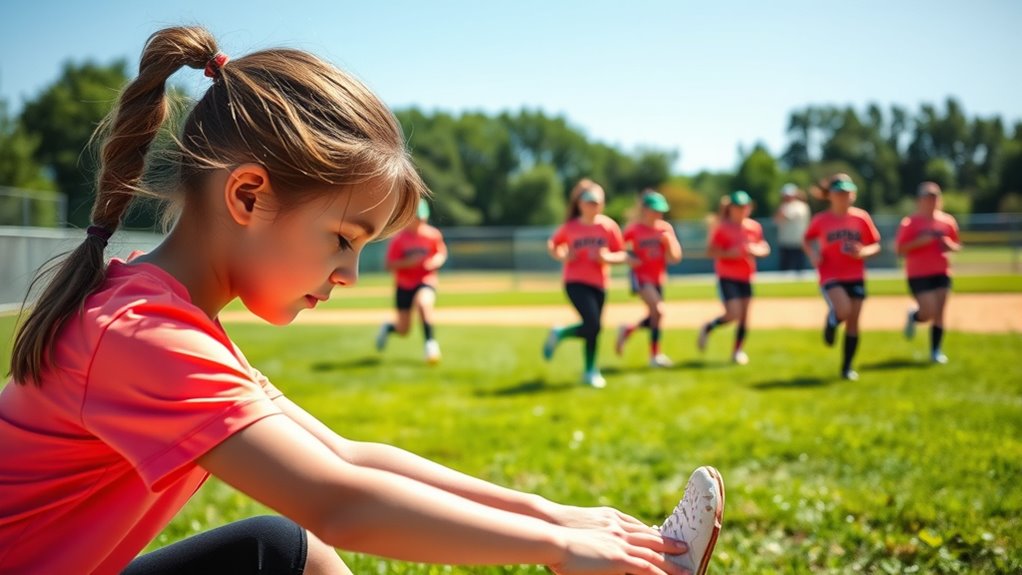
Before diving into intense drills, it’s vital to start with warm-up exercises and stretching. Proper warm-ups prepare your muscles, reduce injury risk, and boost mental focus. Stay hydrated by drinking water beforehand—hydration tips like sipping small amounts regularly help keep you alert and energized. Incorporate dynamic stretches such as arm circles, leg swings, and jogging in place to increase blood flow and loosen muscles. These activities also sharpen your mental focus, helping you stay alert during practice. Remember, warming up isn’t just about physical readiness; it’s about mentally preparing yourself for the game. By dedicating time to these exercises, you’ll enhance your performance and set a solid foundation for the drills ahead. Utilizing warm-up exercises and stretching routines supported by sports science can further optimize your readiness.
Basic Throwing Drills

Getting comfortable with your throwing technique is essential to building accuracy and arm strength. To improve, focus on these basic throwing drills:
Master your throwing technique with these essential drills to boost accuracy and arm strength.
- Long Toss: Gradually increase distance to boost bat speed and develop stronger throws.
- Target Practice: Aim at specific spots to enhance throwing accuracy and consistency.
- Quick Release Drills: Practice fast, controlled throws to improve reaction time and arm speed.
- Partner Toss: Work with a partner to simulate game situations, focusing on precision and smooth motion.
These drills help you refine your mechanics, increase bat speed, and boost throwing accuracy. Consistent practice ensures your throws become more powerful and precise, making you a more reliable player on the field. Remember, mastering these fundamentals sets the foundation for all your softball skills. Proper technique and asset division knowledge can also contribute to better understanding and planning for future financial stability.
Fielding Ground Balls
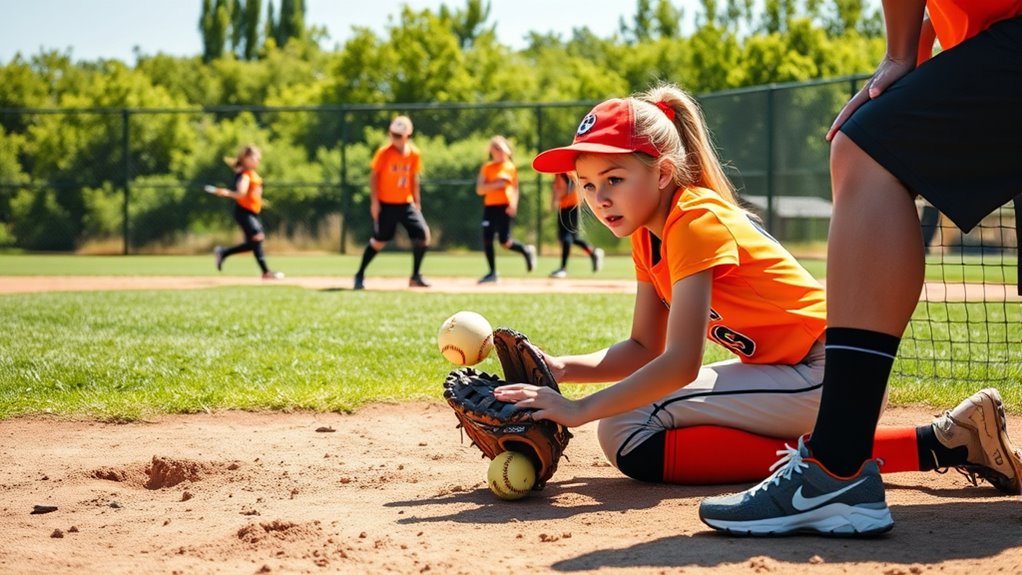
Mastering ground ball fielding is essential for keeping plays alive and preventing runners from advancing. To do this effectively, focus on proper glove positioning—stay low, with your glove flat on the ground, and keep your eyes on the ball. As the ground ball approaches, position your body so you can move smoothly to meet it, using your legs to stay balanced. Controlling ground ball speed is key; slow rollers give you more time, while quick ones require quick reactions. Practice adjusting your stance based on the ball’s speed, staying alert to stay in front of it. Developing proper fielding techniques is crucial for improving your reliability on the field. Consistent drills will help you improve your ability to field ground balls cleanly and confidently, making you a more reliable player on the field.
Catching Fly Balls
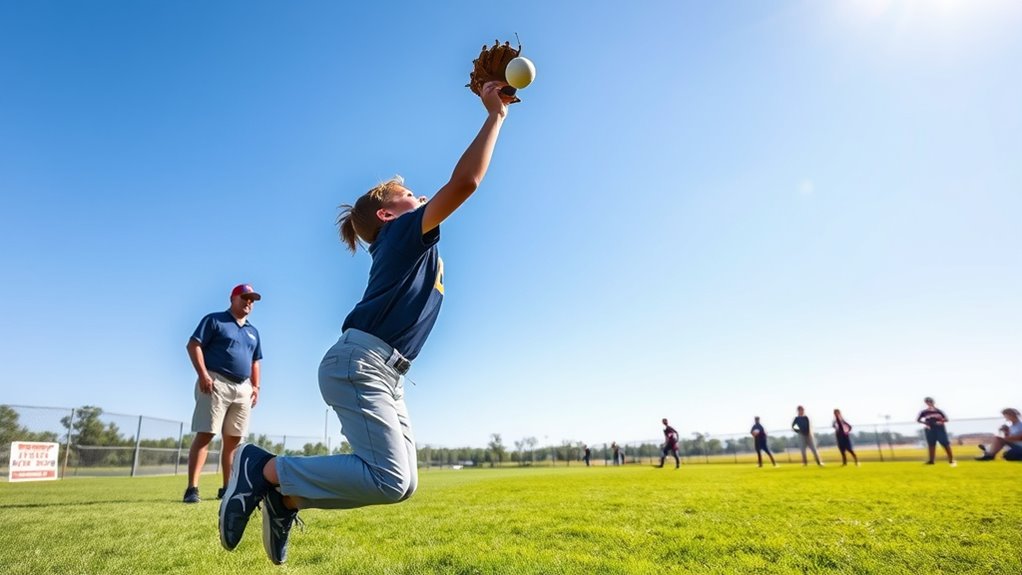
Have you ever struggled to track down a fly ball in the outfield? If so, mastering catching fly balls is essential. Start with proper glove positioning—hold your glove open and steady, ready to catch. Use tracking techniques like keeping your eyes on the ball from the moment it leaves the bat, adjusting your position accordingly. Here are some tips to improve:
- Keep your eyes on the ball at all times.
- Move your feet to stay under the ball.
- Position your glove correctly before the catch.
- Use quick, small steps to adjust your stance.
- Understanding safety considerations such as securing items during play can prevent injuries.
Batting Practice and Hitting Drills
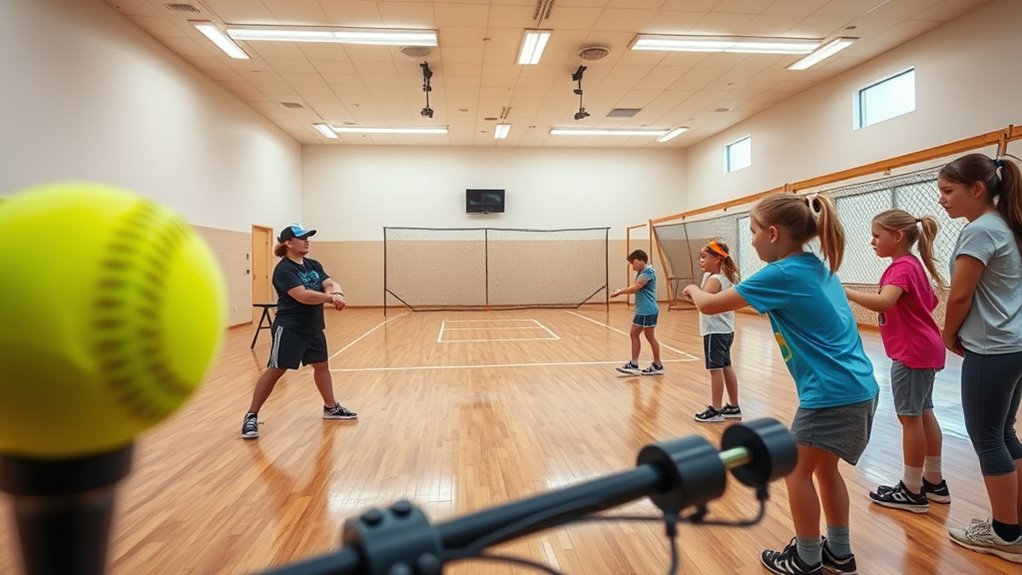
When focusing on batting practice, paying attention to your proper stance sets the foundation for a strong swing. Incorporate swing mechanics drills to improve your timing and consistency at the plate. These techniques help you hit more effectively and build confidence during game situations. Additionally, understanding how automation technologies are transforming sports training can provide insights into optimizing practice routines.
Proper Bat Stance
A proper bat stance is essential for consistent hitting and should feel natural and balanced. Your stance alignment affects power and control, while your bat grip influences swing fluidity. To get started:
- Keep your feet shoulder-width apart for stability.
- Position your knees slightly bent, ready to move.
- Align your hips and shoulders toward the pitcher for ideal timing.
- Hold the bat with a relaxed grip, ensuring your hands are in a comfortable, natural position.
- Regularly assess and adjust your stance to maintain proper space utilization and organization.
Swing Mechanics Drills
Swing mechanics drills are essential for developing consistent and powerful swings during batting practice. These drills focus on refining your bat grip and stance alignment to guarantee proper swing flow. Begin by checking your bat grip—hold the bat firmly but comfortably, avoiding tightness that can restrict wrist movement. Next, focus on stance alignment; your feet should be shoulder-width apart, with your weight balanced evenly. Practice slow swings, paying attention to how your stance influences your swing path. Incorporate drills that emphasize smooth, controlled motions, helping you develop muscle memory. Repeating these drills consistently improves your timing, control, and power. By honing your swing mechanics, you’ll hit more accurately and with greater force, making your batting more effective during games.
Base Running Techniques
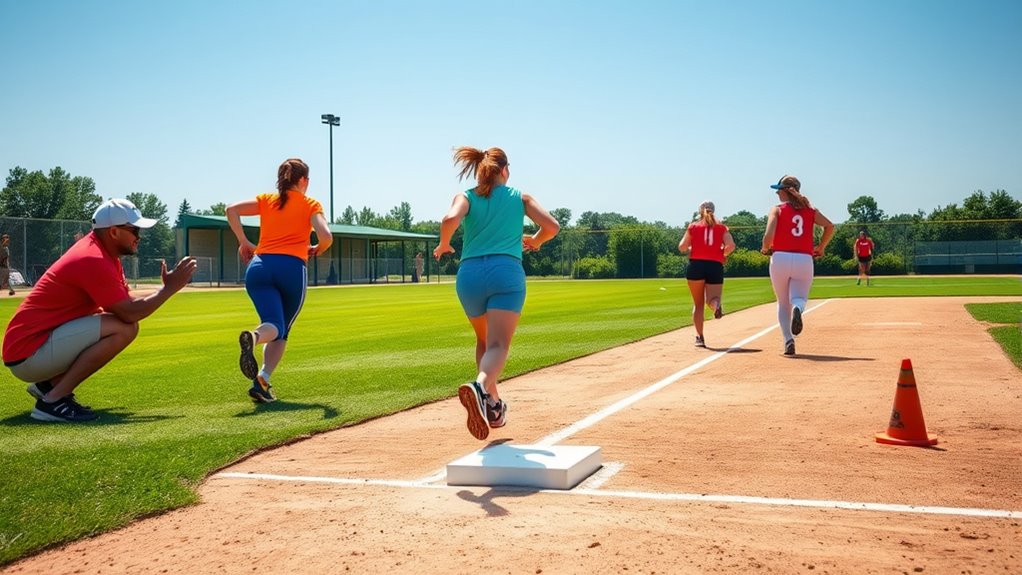
To improve your base running, focus on mastering proper sprint starts to get a quick jump. Remember safety tips when sliding to avoid injuries and stay in control. Paying attention to running form fundamentals will help you move efficiently and confidently around the bases. Additionally, understanding credit card terms can enhance your overall financial literacy as an athlete managing personal expenses.
Proper Sprint Starts
Have you ever wondered what separates a quick, effective sprint start from a sluggish one? The key lies in technique. To optimize your start, consider these steps:
- Position your bat grip comfortably, ensuring it’s loose but controlled.
- Keep your glove fitting snugly to maintain focus and readiness.
- Stand with your feet shoulder-width apart, knees slightly bent.
- As the signal sounds, push off strongly with your back foot, driving forward.
- Incorporate proper sprint start techniques to maximize your explosive power and acceleration.
Focus on explosive movement, using your legs efficiently. Your bat grip shouldn’t interfere with your stance, and a proper glove fitting helps maintain confidence. Remember, a powerful start is all about quick, controlled energy transfer. Practice these steps consistently to improve your base running speed and overall game performance.
Sliding Safety Tips
A safe slide can make all the difference between gaining extra bases and risking injury. To guarantee slide safety, focus on proper sliding techniques that minimize impact and prevent collisions. Always stay low and keep your body close to the ground, using your hands and backside to absorb the shock. Approach the base at an angle rather than straight on to avoid collisions with the baseman. Practice controlled, deliberate slides rather than rushing, and always check your surroundings before sliding into a base. Wearing sliding pads can further protect your knees and legs. Remember, the goal is to slide smoothly and safely, not aggressively. Mastering sliding techniques with safety in mind keeps you injury-free and confident on the bases. Incorporating knowledge about proper slide safety can help prevent unnecessary injuries during practice and games.
Running Form Fundamentals
Good running form is essential for maximizing speed and reducing the risk of injury on the bases. Improving running efficiency relies on proper techniques that enhance stride length and overall movement. Focus on these key fundamentals:
- Keep your body upright with a slight forward lean to propel you forward.
- Shorten your stride to maintain control and avoid overstriding, which hampers efficiency.
- Drive your arms smoothly, keeping elbows at a 90-degree angle to generate momentum.
- Land softly on the balls of your feet to absorb impact and maintain quick, explosive starts.
- Consistent practice of proper running form can also contribute to better overall performance on the field.
Relay and Communication Drills
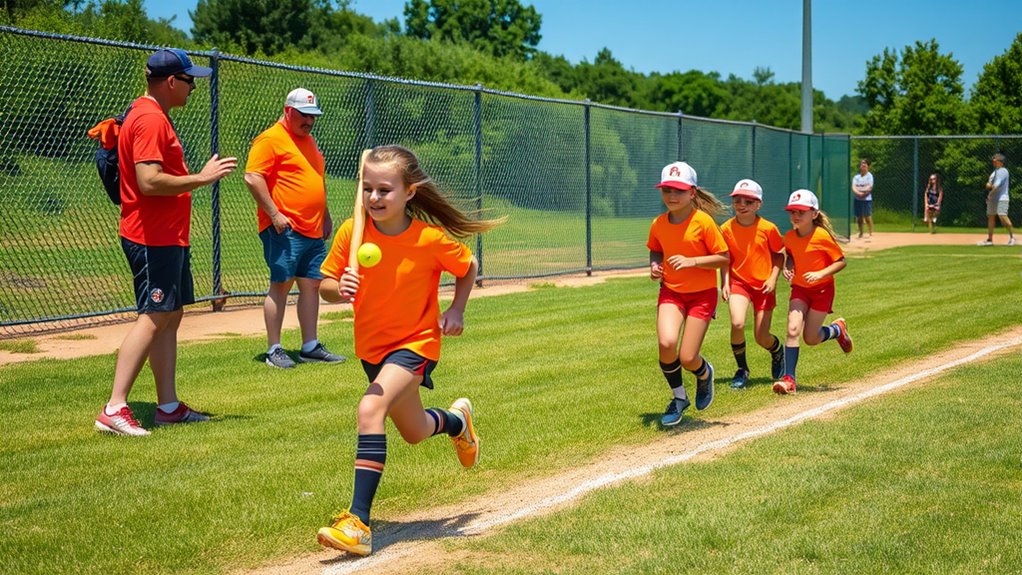
Effective relay and communication drills are essential for ensuring smooth and accurate gameplay. These drills help you master communication signals, so teammates know when and how to pass the ball or alert each other during plays. You’ll practice relay race techniques, focusing on quick, precise handoffs and smooth coordination. Clear communication signals, such as specific calls or visual cues, minimize confusion and delays on the field. During drills, you’ll work on timing your voice commands and gestures to ensure everyone stays synchronized. These exercises enhance your ability to relay information quickly and accurately, which is crucial in fast-paced game situations. Consistent practice builds trust among teammates, making your team more efficient and confident during actual games.
Team Drills for Coordination
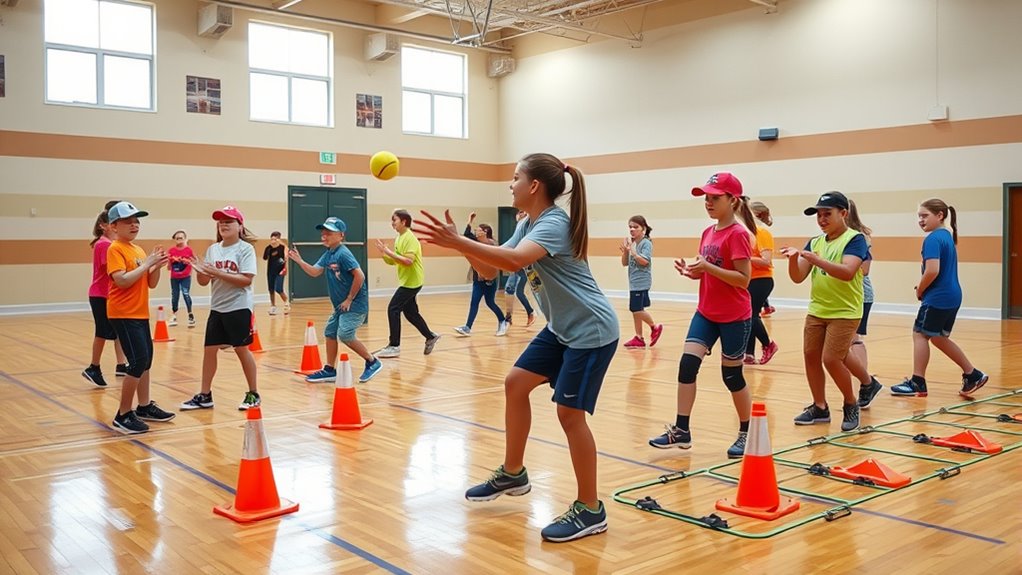
Building on relay and communication drills, team drills for coordination focus on integrating those skills into seamless gameplay. These drills sharpen your team’s ability to work smoothly together, enhancing overall performance. To improve coordination, try these exercises:
Enhance team synergy through relay, communication, and coordination drills for seamless gameplay.
- Cutoff relay drills to practice quick, accurate throws and positioning.
- Run and catch sequences where players work on synchronizing movements.
- Double play simulations to develop teamwork under pressure.
- Rotation drills that emphasize passing and catching in rapid succession.
Situational Play Drills
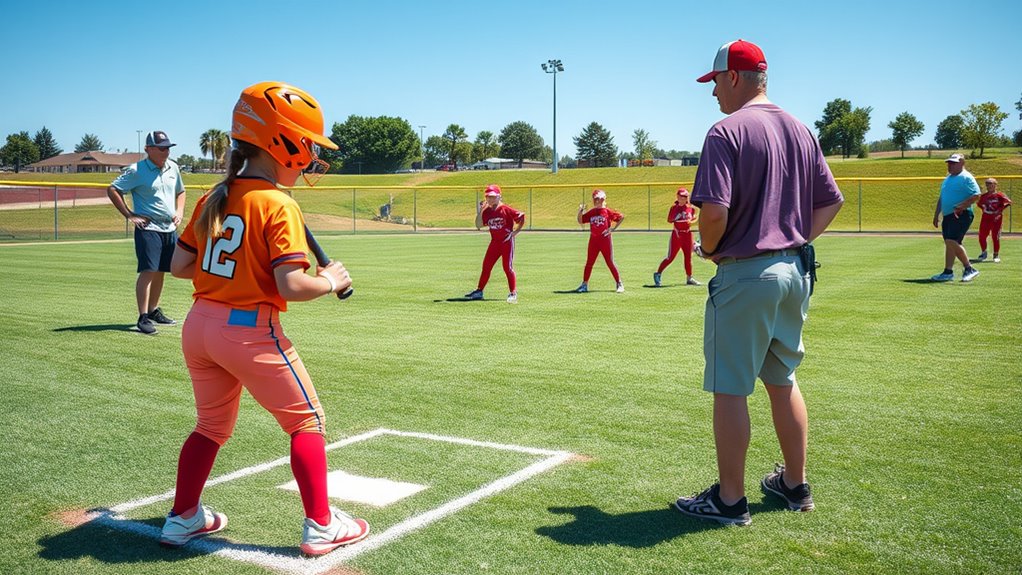
Situational play drills put your skills to the test in game-like scenarios, helping you prepare for real moments on the field. These drills challenge you to make quick decisions under pressure, sharpening your judgment and reaction time. By practicing these situations, you’ll feel more confident when the stakes are high.
Game-Like Scenarios
Game-like scenarios are essential for preparing players to handle real-game situations with confidence. These drills sharpen mental toughness and help you adapt quickly under pressure. When practicing, focus on:
- Simulating late-inning pressure situations to build composure.
- Incorporating unexpected plays to enhance decision-making skills.
- Enforcing quick reactions to mimic game tempo.
- Emphasizing proper nutrition strategies to maintain energy and focus during intense drills.
Decision-Making Under Pressure
Practicing decision-making under pressure is vital for preparing players to respond quickly and accurately in real-game moments. These drills sharpen your ability to evaluate game strategy on the fly, helping you choose the best action in high-stress situations. By simulating real-game scenarios, you develop mental toughness, allowing you to stay focused despite the pressure. For example, you might practice making split-second decisions on whether to throw to first or attempt a double play. These situational play drills boost your confidence, improve your reaction time, and guarantee you remain calm under pressure. Ultimately, consistent practice builds the mental resilience needed to make smart, strategic choices when it matters most during a game.
Cool-Down and Stretching Routines
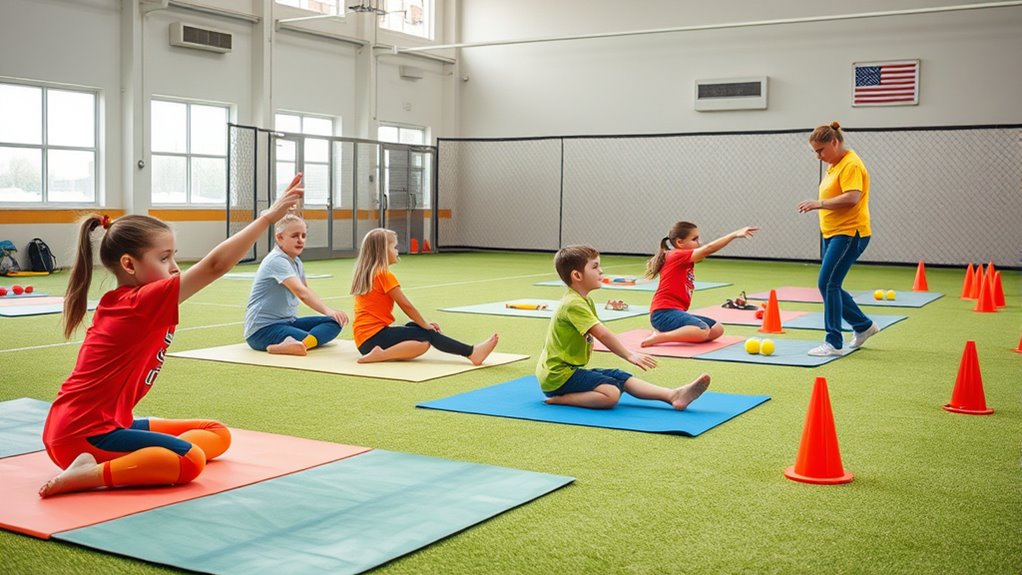
After a rigorous softball practice, taking time to cool down and stretch helps your muscles recover and reduces the risk of injury. A proper cool-down also supports post-game recovery and keeps your equipment in good shape. Here are four key steps to include:
- Light jogging or walking for 5-10 minutes to gradually lower your heart rate.
- Focused stretching on major muscle groups like hamstrings, quads, shoulders, and back.
- Hydrate well to replenish lost fluids and aid muscle repair.
- Inspect your equipment, ensuring bats, gloves, and cleats are clean and in good condition for the next session.
Incorporate these routines consistently to enhance recovery, prevent injuries, and maintain your gear’s longevity.
Frequently Asked Questions
What Equipment Is Essential for Beginner Softball Drills?
For beginner softball training drills, you need essential equipment like a glove, bat, and softball. Make sure to check and maintain your gear regularly to guarantee safety and performance. Cones or bases help with agility drills, and a helmet protects during batting practice. Proper equipment maintenance keeps everything in good condition, so your training is effective and safe. Focus on the basics, and you’ll build a strong foundation for your softball skills.
How Can Beginners Improve Their Throwing Accuracy Quickly?
To improve your throwing accuracy quickly, focus on refining your throwing mechanics. Practice target drills regularly, aiming for specific spots to build consistency. Pay attention to your grip, stance, and follow-through, making adjustments as needed. Repetition helps develop muscle memory, so dedicate time to target practice. With persistent effort and proper technique, you’ll see noticeable improvements in your accuracy and confidence on the field.
What Are Common Mistakes New Players Make During Fielding?
When you’re fielding, you might slip into a poor stance or neglect proper glove positioning. Many new players stand too upright or move late, making it harder to catch the ball cleanly. You should maintain a low, balanced fielding stance and keep your glove ready and properly positioned in front of you. Focus on staying alert and moving quickly, so you don’t miss easy plays or mishandle the ball.
How Do You Motivate New Players During Practice?
Like a coach rallying a team before a big game, you can motivate new players by fostering team bonding and boosting their mental focus. Celebrate small successes, encourage positive communication, and create a supportive environment. Use energetic drills and praise effort over results. When players feel connected and confident, their enthusiasm grows, turning practice into a fun challenge rather than a chore. Your encouragement makes all the difference.
What Safety Precautions Should Be Taken During Drills?
When considering safety precautions during drills, you should always emphasize the importance of protective gear like helmets, gloves, and padding. Make sure players complete proper warm-up routines to prevent injuries. Keep an eye on the equipment to guarantee it’s in good condition, and remind players to stay alert and communicate if they feel discomfort. By prioritizing these safety measures, you create a safer environment for everyone on the field.
Conclusion
Remember, mastering softball takes practice and patience. Just like the “10,000 hours” theory suggests, consistent effort leads to skill improvement. By regularly engaging in these drills, you’ll build a solid foundation and boost your confidence on the field. Keep practicing, stay focused, and trust that each session brings you closer to becoming a better player. With dedication, you’ll see progress faster than you might expect—so stay committed and enjoy the journey!
